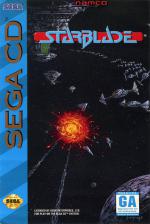
Mean Machines Sega
 1st November 1994
1st November 1994
Categories: Review: Software
Publisher: namco
Machine: Sega CD (US Version)
Published in Mean Machines Sega #26
Starblade
The most intelligent and evil minds in the galaxy have conspired to create Red Eye: a mechanised natural satellite with a hollow core, able to move about the galaxy annihilating planets by means of its incredible power source, Octopus. To your alarm, Red Eye has entered the solar system of the Mother Planet and is on a clearly defined course towards it.
Being a peaceful world, your guard was well and truly down. The defensive fleet is crippled by a surprise attack, and only the Geo Force fighters have a chance of striking at the heart of Octopus and destroying Red Eye.
Origin
Converted from Namco's own Starblade coin-op of 1991 by Namco Home Tek, Starblade has a Star Wars-esque plot.
Game Aim
Battle Stations
The battle takes place over a series of stages, each progressively closer to Red Eye. A meter in the top right of the screen informs you of the remaining distance. The areas are:
-
Home Fleet
The initial fight wends its way between your own flaming battle cruisers. -
Asteroid Field
Stem the oncoming squadrons and outmanoeuvre the asteroid defences. -
Enemy Fleet
Your chance to wreak havoc on the spacecraft carries and motherships of the enemy. -
City
A white-knuckle ride is called for to outflank defences on the path to Octopus. -
Canyons
Steep walled ravines protect the entrance to Red Eye's command centre. -
Maze Defences
A dense construction in space forms the last extra-terrestrial defence of Red Eye. -
Octopus Core
Accessed by a narrow duct, the core is quite resilient to attack and launches a barrage of protective fire.
Vectory Is Mine
Converted quite faithfully from the arcade, Starblade has both the strengths and weaknesses of polygon games like Slipheed. There is no control over the flight path of the Geo Force, meaning the game plays identically each time.
However, unike Slipheed, the game is played from a first-person perspective, with a trigger sight. In order for the Mega-CD to match the level of action on screen, some of the filled-in polygon ships have become wire-frame images.Pass The Port
Starblade utilises the Mega-CD's digital sound capability to create the babble of an intercom. You frequently hear the advice and orders of your wingmen (though these bafflingly bear little resemblance to what's going on). There are also lots of surround sound explosions, that deserve a good stereo system for full effect.
Gus
Not withstanding Namco's careful and comprehensive conversion, the main problem is changing the game from an arcade to home format. Starblade is both visually and aurally impressive successively creating a 'Star Wars' atmosphere.
I also think it's more exciting as a polygon game than Slipheed, which is really just pretty Galaxians. What's more, the trip to Red Eye is action-packed across every kilometre. But the snag is that it's always the same trip. What's great for the odd 50p in the arcade does become a dubious investment at £50. Of course, chasing high scores and even completing the game gives it lasting interest, but Starblade doesn't offer great depth.Paul
Wah-hey, whack on some headphones, sit in a darkened room, and this is one heck of a sensory overload. The visuals are stunning, packing the screen with technically impressive graphics.
But the downfall of this genre is, as ever, the pre-programmd flight path. Interaction with the surroundings is pitifully minimal, resulting in a point-and-shoot affair that, after the first few goes, becomes samey. A good, but ultimately short-lived, effort.
Verdict
P. More than an adequate stab at the grandiose space battle visuals of the arcade.
N. Limited colours, wire-frame compromises and a small portion of the screen used.
Sound 89%
P. Excellent explosions and effects, and the CD vocal track is mostyle clear.
N. The commands of your colleagues are often repeated and have no context to the action.
Playability 86%
P. The trigger happy will be in laser heaven on the way to Red Eye. Gets tough.
N. No control over movement other than the cursor. It's shallow gameplay.
P. High scores to chase. The epilogue after Red Eye is tough.
N. The route and the enemies are always the same. Quickly becomes repetitive.
Value For Money 73%
N. Starblade at home doesn't compare favourably with a cheap thrill on the coin-op.
Overall 75%
An extravagance for shoot-'em-up fans, but by no means a bad game. Just one not naturally suited to a console.
Scores
Sega CD Version| Graphics | 90% |
| Sound | 89% |
| Playability | 86% |
| Lastability | 70% |
| Value For Money | 73% |
| Overall | 75% |


